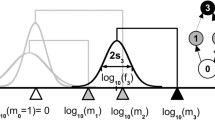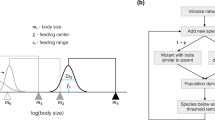The evolutionary patterns of animal species clades in an evolving food web system were examined by computer simulation. In this system, each animal species fed on other species according to feeding preference. The food web system evolved via the appearance and extinction of species. The model succeeded in reproducing evolutionary patterns of diversity similar to those seen in the fossil record. This result indicates that the model reproduced the temporal changes of the rates of colonization and extinction of species in the system, which have been decided a priori in the previous stochastic models. In the food web system, the numbers of both predatory and prey species influenced the temporal diversity patterns in each clade in the system. The number of prey species fluctuated strongly, whereas the number of predatory species gradually increased with time. Therefore, temporal diversity patterns were influenced mainly by the number of predatory species. As a result of the gradual increase of the number of predatory species, it was difficult for each clade to maintain its species diversity for a long time. Slight changes of interspecific interaction can sometimes decide the destiny of a clade. When a clade is faced with extinction, if one predatory species of the clade becomes extinct and one or two prey species of the clade appear, the species diversity in the clade increases again. This result indicates that slight changes of interspecific interaction sometimes decide the destiny of a clade.
Similar content being viewed by others
References
Alvarez L. W., Alvarez W., Asaro F. & Michel H. V. (1980) Extraterrestrial cause for the Cretaceous-Tertiary extinction: experimental results and theoretical interpretation. Science 208: 1095–1108.
Bambach R. K. (1983) Ecospace utilization and guilds in marine communities through the Phanerozoic. In: Biotic Interactions in Recent and Fossil Benthic Communities (eds M. J. S. Tevesz & P. L. McCall), pp. 719–746. Plenum, New York.
Chin K. (1997) What Did Dinosaurs Eat? The Complete Dinosaur (eds J. O. Farlow & M. K. Brett-Surman) chapter 26. Indiana University Press, Bloomington, Indiana. http://www.indiana.edu/~iupress/books/0-253-33349-0ex2.html.
Cohen J. E., Pimm S. L., Yodzis P. & Saldana J. (1993) Body size of animal predators and animal prey in food webs. Journal of Animal Ecology 62: 67–78.
Elder W. P. (1989) Molluscan extinction patterns across the Cenomanian–Turonian boundary in the western interior of the United States. Paleobiology 15: 299–320.
Erwin D. H. (1990) End-Permian. In: Palaeobiology, a Synthesis (eds D. G. E. Briggs & P. R. Crowther) pp. 187–194. Blackwell Scientific Publications, Oxford.
Futuyma D. J. (1986) Evolutionary Biology. Sinauer Associates, Inc, Sunderland, Massachusetts.
Gardner M. R. & Ashby W. R. (1970) Connectance of large dynamic (cybernetic) systems: critical values for stability. Nature 228: 784.
Gilpin M. E. (1994) Community-level competition: asymmetrical dominance. Proceedings of the National Academy of Science of the United States of America 91: 3252–3254.
Gould S. J., Raup D. M., Sepkoski J. J. Jr, Schopf T. J. M. & Simberloff D. S. (1977) The shape of evolution: a comparison of real and random clades. Paleobiology 3: 23–40.
Hallam A. (1984) Pre-Quaternary sea-level changes. Annual Review of Earth and Planetary Science 12: 205–243.
Happel R. & Stadler P. F. (1998) The evolution of diversity in replicator networks. Journal of Theoretical Biology 195: 329–338.
Hayami I. & Hosoda I. (1988) Fortipecten takahashii, a reclining pectinid from the pliocene of north Japan. Palaeontology 31: 419–444.
Hirano H., Toshimitsu S., Matsumoto T. & Takahashi K. (1999) Bioevents and paleoenvironmental changes in Mid-Cretaceous. Fossil 66: 47–49 (in Japanese with English abstract).
Holt R. D. (1977) Predation, apparent competition, and the structure of prey communities. Theoretical Population Biology 12: 197–229.
Holtz T. R. J. (2003) Dinosaur predation. In: Predator–Prey Interactions in the Fossil Record (eds P. H. Kelley, M. Kowalewski & T. A. Hansen) pp. 325–340. Kluwer Academic/Plenum Publishers, New York.
House M. R. (1989) Ammonoid extinction events. Philosophical Transactions of the Royal Society of London, Series B 325: 307–326.
Jennings S., Pinnegar J. K., Polunin N. V. C. & Boon T. W. (2001) Weak cross-species relationships between body size and trophic level belie powerful size-based trophic structuring in fish communities. Journal of Animal Ecology 70: 934–944.
Kelley P. H., Kowalewski M. & Hansen T. A. (2003) Predator–Prey Interactions in the Fossil Record. Kluwer Academic/Plenum Publishers, New York.
Kennedy W. J. (1977) Ammonite evolution. In: Patterns of Evolution: as Illustrated by the Fossil Record (ed. A. Hallam) pp. 251–304. Elsevier, Amsterdam.
Kolata G. B. (1975) Paleobiology: random events over geological time. Science 189: 625–626, 660.
Larwood G. P. (1988) Extinction and Survival in the Fossil Record. Clarendon Press, Oxford.
Maurer B. A. (1999) Untangling Ecological Complexity. The Macroscopic Perspective. University of Chicago Press, Chicago.
May R. M. (1972) Will a large complex system be stable? Nature 238: 413–414.
Nakajima T. (1995) Experimental evolution – a perspective based on evolutionary ecology of bacteria. Japanese Journal of Ecology 45: 43–56. (in Japanese with English abstract).
Neubert M. G., Blumenshine S. C., Duplisea D. E., Jonsson T. & Rashleigh B. (2000) Body size and food web structure: testing the equiprobability assumption and the cascade model. Oecologia 123: 241–251.
Pahl-Wostl C. (1997) Dynamic structure of a food web model: comparison with a food chain model. Ecological Modelling 100: 103–123.
Raup D. M. (1992) Large-body impact and extinction in the Phanerozoic. Paleobiology 18: 80–88.
Raup D. M., Gould S. J., Schopf T. J. M. & Simberloff D. S. (1973) Stochastic models of phylogeny and the evolution of diversity. Journal of Geology 81: 525–542.
Raup D. M. & Stanley S. M. (1971) Principles of Paleontology. W. H. Freeman and Company, San Fransisco.
Rosenzweig M. L. (1995) Species Diversity in Space and Time. Cambridge University Press, Cambridge.
Sato T. & Tanabe K. (1998) Cretaceous plesiosaurs ate ammonites. Nature 394: 629–630.
Schopf T. J. M. (1974) Permo-Triassic extinctions: relation to sea-floor spreading. Journal of Geology 82: 129–143.
Sepkoski J. J. Jr (1979) A kinetic model of Phanerozoic taxonomic diversity. II. Early Phanerozoic families and multiple equilibria. Paleobiology 5: 222–251.
Sepkoski J. J. Jr (1996) Competition in macroevolution: the double wedge revisited. In: Evolutionary Paleobiology (eds D. Jablonski, D. H. Erwin & J. H. Lipps), pp. 211–255. The University of Chicago Press, Chicago and London.
Simberloff D. S. (1974) Permo-Triassic extinctions: effects of area on biotic equilibrium. Journal of Geology 82: 267–274.
Stanley S. M., Signor P. W. I., Lidgard S. & Karr A. F. (1981) Natural clades differ from ‘random’ clades: simulations and analyses. Paleobiology 7: 115–127.
Tokita K. & Yasutomi A. (1999) Mass extinction in a dynamical system of evolution with variable dimension. Physical Review E 60: 682–687.
Tokita K. & Yasutomi A. (2003) Emergence of a complex, symbiotic and stable ecosystem in replicator equations with extinction and mutation. Theoretical Population Biology 63: 131–146.
Valentine J. W. & Moores E. M. (1970) Plate-tectonic regulation of faunal diversity and sea level: a model. Nature 228: 657–659.
Vermeij G. J. (1977) The Mesozoic marine revolution: evidence from snails, predators and grazers. Paleobiology 3: 245–258.
Vermeij G. J. (1983) Traces and trends of predation, with special reference to bivalved animals. Palaeontology 26: 455–465.
Vermeij G. J. (1987) Evolution and Escalation. Princeton University Press, Princeton, New Jersey.
Vézina A. F. (1985) Empirical relationship between predator and prey size among terrestrial vertebrate predators. Oecologia 67: 555–565.
Ward P. D. (1992) On Methuselah’s Trail. John Brockman Associates, New York.
Warren P. H. & Lawton J. H. (1987) Invertebrate predator-prey body size relationship: an explanation for upper triangular food webs and patterns in food web structure? Oecologia 74: 231–235.
Wignall P. B. & Hallam A. (1992) Anoxia as a cause of the Permian/Triassic mass extinction: facies evidence from northern Italy and the western United States. Palaeogeography, Palaeoclimatology, Palaeoecology 93: 21–46.
Wignall P. B. & Twitchett R. J. (1996) Oceanic anoxia and the end Permian mass extinction. Science 272: 1155–1158.
Yoshida K. (2002) Long survival of ‘living fossils’ with low taxonomic diversities in an evolving food web. Paleobiology 28: 464–473.
Author information
Authors and Affiliations
Corresponding author
About this article
Cite this article
Yoshida, K. Dynamics of evolutionary patterns of clades in a food web system model. Ecol Res 18, 625–637 (2003). https://doi.org/10.1111/j.1440-1703.2003.00585.x
Received:
Accepted:
Issue Date:
DOI: https://doi.org/10.1111/j.1440-1703.2003.00585.x




